W. & S. Jones
John Jones and Son
John Jones, 1737 - 1808
William Jones, 1762 - 1831
Samuel Jones, 1770 - 1859
by Brian Stevenson
last updated May, 2024
William and Samuel Jones turned their father’s modest London optical shop into a major producer and retailer of microscopes and other scientific apparatus. Their business was built through a series of moves that synergized with each other:
William wrote and self-published several books on scientific and engineering topics, and presented public talks on those subjects. He also bought the publishing rights to the popular scientific works of Benjamin Martin (ca. 1705 - 1782) and George Adams Jr. (1750 - 1795) immediately after those men’s deaths. The Jones brothers profited from reprinting those books numerous times, well into the nineteenth century. Moreover, the Jones’ editions of those books included extensive catalogues of their products, alerting readers that they could purchase items described in the books directly from the Joneses.
Those multi-page catalogues, also published separately, were a novel, positive business move, informing potential customers on exactly what was readily available. Previously, detailed catalogues were not commonly used, requiring a customer to physically visit a shop, or to inquire through the post on what was available. The Jones’ long lists of microscopes, telescopes, scientific apparatus, and technological amusements could be leisurely perused at home.
The Jones also made substantial improvements to existing microscope patterns. Through their catalogues and books, they effectively “branded” their designs, such that even their competitors produced “Jones Improved” and “Jones Most Improved” microscopes (Figures 1 and 2). Other instruments that they marketed, but did not invent, became associated with their name, such as the “Jones botanical” and “Jones flower” microscopes (Figures 3 and 13).
By combining their high quality optical, scientific, and mathematical products with innovative marketing techniques (as well as shrewd real estate investments) both William and Samuel died as very wealthy men.

Figure 1.
Jones “Improved” microscopes. Left, from their 1798 edition of George Adams Jr.’s “Essays on the Microscope” - note that the illustration branded this as “Jones”. Center and right, surviving examples, both signed by W. & S. Jones. This model was based on John Cuff’s popular microscope, originally designed in the 1740s. George Adams Jr. called this the “Adams Improved Double and Single Microscope” in his first, self-published edition of “Essays on the Microscope”. Images adapted for nonprofit, educational purposes from internet auction sites.

Figure 2.
Jones “Most Improved” microscopes. Left, image from their 1798 edition of George Adams Jr.’s “Essays on the Microscope” - note that it was branded “Jones” in the illustration. Center and right, surviving examples, both signed by W. & S. Jones. It was described as the “new improved universal microscope” in the 1787 Jones and Son catalogue (see Figure 8). This model was a variant of Benjamin Martin’s “Universal” and George Adams Jr.’s “Improved Compound” microscopes. Images adapted for nonprofit, educational purposes from internet auction sites.

Figure 3A.
A type of microscope that is often called the “Jones Botanical”. Contemporaries credited the original design to Benjamin Martin. In addition, George Adams Jr. certainly produced this design before Jones. The first versions had two lenses that could pivot into position, to change the magnification. Such instruments are rather rare nowadays.
(Left) Illustration from George Adams Jr.’s 1787 “Essays on the Microscope”.
(Center) Illustration from the 1798 edition of Adams’ “Essays on the Microscope”, published by W. and S. Jones, where it was described as “Jones Universal Pocket Microscope”.
(Right) A surviving two-lens microscope. It is structurally similar to those known to have been made by W. & S. Jones, and is likely to have been made by them, ca. 1795.

Figure 3B.
Later versions of the “Jones Botanical” microscope had three pivoting lenses.
(A) Illustration of the “New Universal Pocket Microscope” by W. and S. Jones, illustrated in Charles Hutton’s “A Mathematical and Philosophical Dictionary”, Volume 2, 1795.
(B) The simple form of Jones’ microscope, with three lenses. Focus is achieved by sliding the stage up-and-down on the square stem. This form is generally not found with a maker’s signature.
(C) The complex form of Jones’ universal pocket microscope, which includes a vertical thumbscrew fine focus. This option is noted in the 1798 and 1795 illustrations (Figure 3A and Figure 3B-A). This form is usually found with W. & S. Jones' signature.
(D) These microscopes were designed to be used vertically, on a table top, or horizontally in the hand. Looking toward a bright light served as illumination. Microscope images adapted for nonprofit, educational purposes from internet auction sites.

Figure 4.
Two simple microscopes that are very similar to the “Jones Botanical”, with only two pivoting lenses, and lacking mirrors. George Adams Jr.’s version of this microscope had only two lenses, but included a mirror (see Figure 3A). Those features, combined with the red-painted cases, suggest that these microscopes were produced by Benjamin Martin, who was credited by contemporaries of having created this design. Adapted for nonprofit, educational purposes from (Left) The Oxford Museum of the History of Science online collection, and (Right) The Science Museum of London, https://collection.sciencemuseum.org.uk/objects/co8091/botanical-microscope-early-form-without-mirror-i.
Patriarch John Jones was born in about 1737. Records show that son Samuel was later admitted to the Spectaclemakers’ Guild by patrimony, indicating that John was a master of that guild. It is not known with whom he trained. John married Elizabeth Tomkins on November 27, 1757 at the parish church of Saint Andrew Holborn, London. Both were described at the time as being members of that parish.
John and Elizabeth are known to have had two children: William, baptized in June, 1762, and Samuel, baptized in February, 1770. Both were baptized in the Saint Andrew Holborn parish church.
William is known to have trained with his father, and it is likely that Samuel received similar training. That would have eliminated the unnecessary and expensive requirements of formal apprenticeships for the boys. William became acquainted with Benjamin Martin, and studied with him for a while. Some writers have suggested that William Jones might have been Martin’s formal apprentice, although all known evidence argues against that hypothesis.
William formed a partnership with his father in about 1780. In 1782, the twenty year-old William published a booklet of which he was the sole author, “The Description and Use of a New Portable Orrery” (Figure 5). The booklet was stated to be “printed for John Jones, at his shop, No. 135, near Furnivall’s Inn, Holborn”, and included an advertisement for globes, “optical, mathematical, and philosophical instruments” at the shop of “John Jones”. William evidently had a lot of independence in 1782, but the shop still operated under his father’s name.
The second edition of William’s orrery book, published in 1784, listed him as the publisher, and did not mention his father at all (Figure 6).
Known examples of this orrery are signed by either William Jones or W. & S. Jones (Figure 7).
Benjamin Martin died in 1782. William Jones acquired rights to Martin’s popular books, and reprinted many of them over the next decades. Moreover, Martin’s death opened room in the market for a supplier of quality optical and scientific instruments.
Stating the business name to be “John Jones and Son”, a catalogue was issued in 1787 (Figure 8). It included over a dozen different types of microscopes, including “the new improved universal microscope” (Figure 9), “solar microscopes in brass” (Figure 9), “the new opake and transparent solar microscope, and best compound ditto, packed together in one mahogany box” (Figure 10), “the camera obscura, or lucernal microscope as improved by W. Jones” (Figure 12), “Wilson’s single pocket microscopes” (i.e. screw barrel microscopes), and “collections of microscopical objects of all species, properly prepared and arranged, for the microscope”. The “pocket microscopes for opake objects”, ranging in price from £1 16s to £2 12s 6d were probably the “Universal Pocket microscope” (a.k.a. “Jones’ botanical”, Figure 4, above). The “botanic microscopes for flowers, &c.”, priced from 5s to £1 11s 6d, were probably the handheld, folding instruments that are nowadays often called “Jones flower microscopes” (Figure 13).
William was clearly in control of the business by this time, and may have been sole owner, with John’s name included for continuity. The 1787 catalogue includes this statement: “William Jones, (the son) begs leave to inform the Public, that the Mathematical principles of Natural and Experimental Philosophy have been his study and attention from his youth. That all instruments manufactured by him, or under his immediate inspection, are peculiarly attended to in regard to perfection, uniformity, and neatness; and as the choice of their workmen is of the best, and most judicious, so their instruments will be warranted to be equal in every respect, to those fabricated by any other workman whomsoever. And for conveniency of their customers, (and no others) private instructions may be had, in the nature and use of any Philosophical, Mathematical, &c. instrument”.
In 1788, William Jones published a new edition of Benjamin Martin’s Description and Use of a Case of Mathematical Instruments. This booklet included a two-page price list of “Mathematical, etc. Instruments, made and sold, by J. Jones and Son, 135 Holborn, London”.
Despite the business name, John was evidently out of the picture by this time. I have not found his name associated with the business after 1788. John Jones retired to Islington, and died there in 1808.
William wrote a business letter to Thomas Jefferson in 1789, when the latter was U.S. Minister to France, “Sir, Herewith you receive the Two Thermometers, and I believe tolerably consistent with the description contained in the favour of your Letter. Being confined to a small period of time, and that near the most busy of Times, Christmas, I was prevented from paying that peculiar attention to the process in the fabrication of your Thermometers, as I wished. The essential parts, The Tubes and Scales I know to be good and the mounting in the larger to be eligible for your purpose. The smaller one is not immediately contrived for the same suspension but may be easily so placed as to be so by fixing 2 perpendicular pieces of wood to the side of your window, and the Thermometer placed against them as per annexed figure. If these should not please, upon more time being allowed I’ll make two others for you and take these back, as I am always desirous to make Instruments singularly exact and complete when intended for nice experiments and observations. I have made some small additions to my Portable Orrery the Description of which I have enclosed as a small present to you. Ere long Sir I expect to be in Paris and if there is any Instrument or Instruments, that I can take the charge of for yourself or friends The order for them will be a peculiar favour to, Sir, Your Much Obliged and Obedt. Servt., Wm. Jones.”
Younger brother Samuel joined the business in about 1791. W. & S. Jones issued an extensive catalogue that year (Figure 11).
The Jones brothers continued to re-issue Martin’s tracts. In 1793, another edition of Description and Use of the Pocket Case of Mathematical Instruments, was issued, although this one was “revised and augmented by William Jones, mathematical instrument-maker”. (Figure 16).
Instrument-maker and scientific author George Adams Jr. died in 1795. The Jones brothers purchased the rights to several of Adams most popular books, which they revised and re-issued over the next several decades, often adding their own catalogues into the bound books. They may also have acquired items from Adams’ stock of apparatus.
Their 1797 edition of Adams’ Geometrical and Graphical Essays was “corrected and enlarged by William Jones, mathematical instrument maker”. A reviewer wrote, “The character of this work is already well known to the public. It contains a large quantity of useful matter, treated with much perspicuity, and illustrated by a number of accurate and beautiful engravings. Mr. Jones has considerably augmented and improved the present edition”.
Adams’ Essays on the Microscope was re-issued in 1798. This included a numerous illustrations of microscopes, annotated with comments related to the Jones shop. The “Jones Improved” and “Jones Most Improved” microscopes were first described in this edition (see Figures 1 and 2, above). Included in the back was a 16-page catalogue of Jones microscopes and other apparatus, and a list of books by William Jones, Benjamin Martin, and George Adams (Figure 18).
Catalogues inserted into Jones’ publications from 1799 and 1800 indicate that moved their shop between those printings, from 135 to 30 Holborn (Figure 21).
As noted above, William Jones cultivated a relationship with Thomas Jefferson. Presumably, he also made the acquaintance of other influential people. We know from letters in Jefferson’s archives that he made several substantial purchases from W. and S. Jones during the early 1800s. Among these was a sextant that was carried by Meriwether Lewis and William Clark on their 1804-1806 expedition cross America to the Pacific Ocean and back (Figure 22).
An 1807 letter by William Jones to Jefferson gives insights into both the quality of Jones’ apparatus, and the skills of the makers, “Sir, I was honored with your’s of last year, Dated Octr 25th. and have used my best endeavours to execute such Instruments for you as I thought would best answer your purpose. As you expressed that you wanted the Astronl Quadt for an important purpose, & that Instrument, being on a confined and limited principle of Accuracy I judged it best to send you the Reflecting Circle. This Instrument will enable you to take angular distances in all directions, to the accuracy of 20 seconds or less and whether for the purpose of determining the latitudes & longitudes of places, altitudes or azimuths triganometl angles for Surveys on land, &c, &c, this is the most portable & convenient Instrument accompanied with the Quicksilver horizon & stand, it constitutes a general or complete small portable Observatory The principle of it’s construction you will see is evidently the same as that of the Hadley’s Quadrant or Sextant but from it’s having three additional indices, when by a little practice you are acquainted with the ready management of the Instrument you will be enabled to detect & correct every possible Error of the Instrument however well it may be made viz: the Error of the center (if any) by reading off at the 3 parts of the Limb; the inequality of the divisions (if any) by changing the positions of the indices and the Errors of the Dark Glass Shades by turning the Glasses half from each angle. After your acquaintance with the particulars I have no doubt of your approving of the Instrument & it’s being adopted to your purpose. To the Box Sextant I have placed platina Limb which is a harder metal than Gold or Silver & will under the fine divisions by time less liable to be defaced. We doubt not but these articles will arrive to you perfectly safe, and hope they will give you full satisfaction & merit the favor of your future commands. I have the Honor to be, Sir, With much Respect Your obliged hble Servt. Wm Jones”.
Apparatus from W. & S. Jones was acquired by many other scientifically-inclined people and educational institutions. In the USA, Harvard University, Transylvania University, and the University of North Carolina are all known to have made substantial purchases during the first three decades of the nineteenth century. Charles Bancker (1778-1869), a wealthy Philadelphia insurance and shipping agent acquired a considerable number of specialized instruments from W. & S. Jones.
From the time the business was owned by father John Jones, the firm had employed workmen. As noted above, William’s 1787 catalogue stated that “all instruments manufactured by him, or under his immediate inspection … (and) … the choice of their workmen is of the best”. William’s 1789 letter to Thomas Jefferson, reprinted above, includes a note that he did not always directly supervise production, “I was prevented from paying that peculiar attention to the process in the fabrication of your Thermometers, as I wished”. Some of their workmen may have worked at the Jones shop, while others were contractors who worked from their own homes. Two examples are known that illustrate this common practice:
The National Museums of Scotland possess a Bohnenberger gyroscope by W. and S. Jones (Figure 23). The central rotor is made of hollow wood, and includes several weighted plugs. Upon investigation of the interior, museum curators discovered the signature of the maker, William Stiles. He had also written the year of manufacture, 1831.
William Hill Darker (1811-1864) was a maker of precision polarizing and other mineralogical apparatus. In 1844, a London agent for Charles Bancker wrote of a meeting with Darker, “Mr. Darker is chiefly employed by the principal philosophical apparatus houses, and has made (he doubts not) many of the articles you have procured from Jones and others. At first he seemed reluctant to undertake anything except through the houses; but, after a little conversation, I induced him to assent, promising on my part, immediate payment for whatever he might supply. If at any time you … come to an ecclaircissement with Mr. Jones, don’t name Darker as your present resource, because it may be prejudicial to him with such houses”. A W. & S. Jones polarimeter, which is the type of apparatus at which Darker excelled and was undoubtedly produced by him, is shown in Figure 24.
By 1831, neither William nor Samuel appear to have been consistently managing the day-to-day operations of their business. William had houses in Islington and Brighton, and Samuel had a house in St. Albans.
William passed away on February 17, 1831, “At his house in Brighton, aged 68, William Jones, Esq. of Islington, and of the firm of W. & S. Jones, Opticians, Holborn. He was brought forward under his father John Jones, an optician of some eminence, and early discovered an extraordinary force of understanding, with a disposition to cultivate it to the utmost, in mathematical and philosophical research, which was much assisted by his frequent intercourse with that very eminent optician and voluminous writer Mr. Benjamin Martin, of Fleet-street. He also employed his leisure hours in privately teaching Astronomy, Mathematics, and Practical Surveying, and in a few instances gave public lectures on Astronomy. These circumstances introduced him to the society of the most eminent mathematical and astronomical professors of the time, Drs. Priestley, Hutton, Maskelyne, Professor Vince, and others. But during these pursuits, his industry and attention, in conjunction with his brother and surviving partner Samuel Jones, were constantly exercised in an extensive practical execution of his profession, which proved the means of introducing many skillful workmen as manufacturers of optical and mathematical instruments. Mr. W. Jones published Descriptions of the Orrery; of a Case of Mathematical Instruments; and of Hadley's Quadrant. The whole of the late George Adams's Works were re-published by him, with additions and improvements. To the Encyclopedia Britannica and Rees's Encyclopedia he was a considerable contributor. In the latter period of his life he was obliged by illness to withdraw from the anxiety of business, and chiefly resided at Brighton, where he was never so pleasingly engaged as in imparting his knowledge to his young and scientific friends. In society he was cheerful and interesting, full of philosophical and literary anecdotes, which he often dealt out with great good humour. He has left the entire of his property (excepting a few Iegacies), including an extensive library of scarce mathematical books, to his brother Samuel Jones”. On a related note, neither William nor Samuel married.
Despite William’s death, Samuel retailed the business name “W. & S. Jones”. An 1837 catalogue offered about twenty different sorts of microscopes (Figure 25). These included modernized forms, such as “a new universal pocket microscope” (Figure 26) and “Jones’ new improved universal microscope”, and variants of old patterns such as screw barrel microscopes (“Wilson’s single pocket microscopes”) and Culpeper microscopes (“compound three pillar microscopes”).
The first national census of England was conducted during March, 1841. On census day, Samuel Jones was at his home in St. Albans. The 1851 census also found Samuel at his St. Albans home, and described his occupation as “optician and farmer”. Evidently a gentleman farmer, he was attended by a cook, a housemaid, and a coachman.
As for the shop at 30 Holborn Hill, in 1841 it was occupied by a 15 year-old “optician” named John Dillon (he was than an apprentice), his 40 year-old cousin, Elizabeth Dillon (without stated occupation), and a maid. John Dillon became a member of the Spectaclemaker’s guild in 1844, giving 30 Holborn Hill as his address. His younger brother, George Dillon, joined the Clock Maker’s guild in 1847, while also living at 30 Holborn Hill. Both were listed as “journeyman mathematical instrument makers” on the 1851 census, and were in the nearby home of their parents on census evening. That evening, the Jones shop was occupied by Elizabeth Dillon, now listed as “house keeper”, and a maid. Curiously, Elizabeth relationship to the head of the household was listed as “cousin”. It is likely that John and/or George Dillon lived at 30 Holborn Hill in 1851, one or both serving as the manager. Probably not a coincidence, John and George Dillon’s grandfather, John Dillon, had been the printer for many of W. & S. Jones’ books.
At the great London Exposition of 1851, W. & S. Jones displayed only “a mountain thermometer”.
Samuel Jones died at his St. Albans home on December 15, 1859.
The business of W. & S. Jones was dissolved on December 25, 1859. Having no heirs, Samuel’s personal property and the stock of W. & S. Jones were sold at auction the following March (Figure 35). The next year’s census shows that the 30 Holborn Hill shop was then occupied by a cabinet maker named William Andrews. The 1861 census also showed George Dillon to be a “mathematical instrument maker” in Clerkenwell, London, and John Dillon to be a “brass finisher”, also in Clerkenwell. Neither they, nor anyone else, appear to have claimed to be successor to W. & S. Jones.

Figure 5.
Excerpts from William Jones’ first edition of his book on his portable orrery (1782). Left, the title page, noting William as the sole author, and father John as the publisher. Right, an advertisement for globes and other apparatus that were available from John Jones’ shop.

Figure 6.
Title page from William Jones’ 1784, second edition of his booklet that described his portable orrery. This edition lists him as the publisher, and does not mention his father.

Figure 7.
A portable orrery by William Jones, ca. 1784. Two sets of geared apparatus can be placed on the base, and cranked to orbit a brass sun: the planets Mercury through Saturn, with their known moons and rings (center, left), and Earth tilted on its axis, with a revolving moon (center, right). Images adapted for nonprofit, educational purposes from an internet sale site.
Figure 8, 1787 catalogue from Jones and Son:
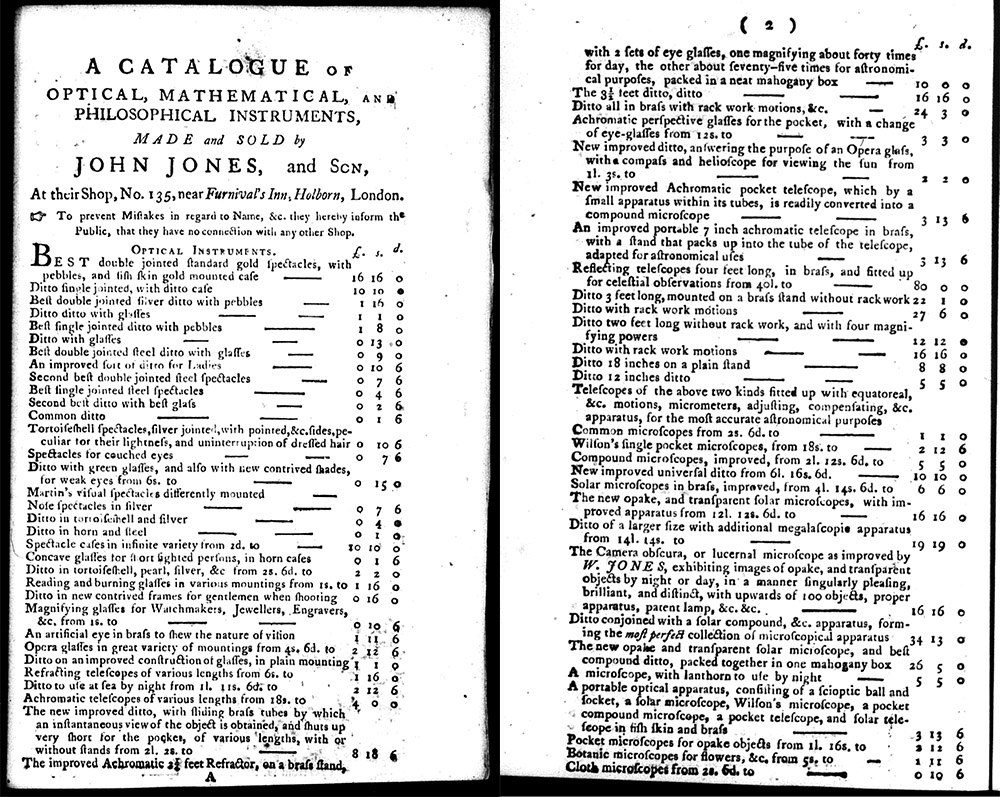





Figure 8.
The first known catalogue from Jones and Son, 1787. It included numerous books that were published by William Jones, and books that were written by the late Benjamin Martin, the rights to which were owned by William Jones.
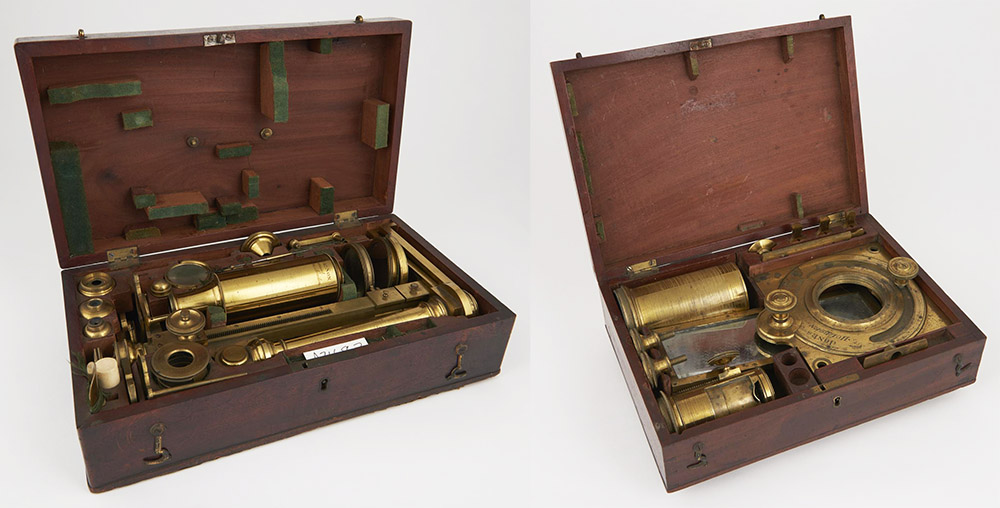
Figure 9.
Cased microscopes that are signed “Jones and Son”. Left, described as the “new improved universal microscope” in the 1787 catalogue (Figure 8, above). Right, a solar microscope. Images adapted for nonprofit, educational purposes from https://collection.sciencemuseumgroup.org.uk/people/cp104399/j-jones-son.
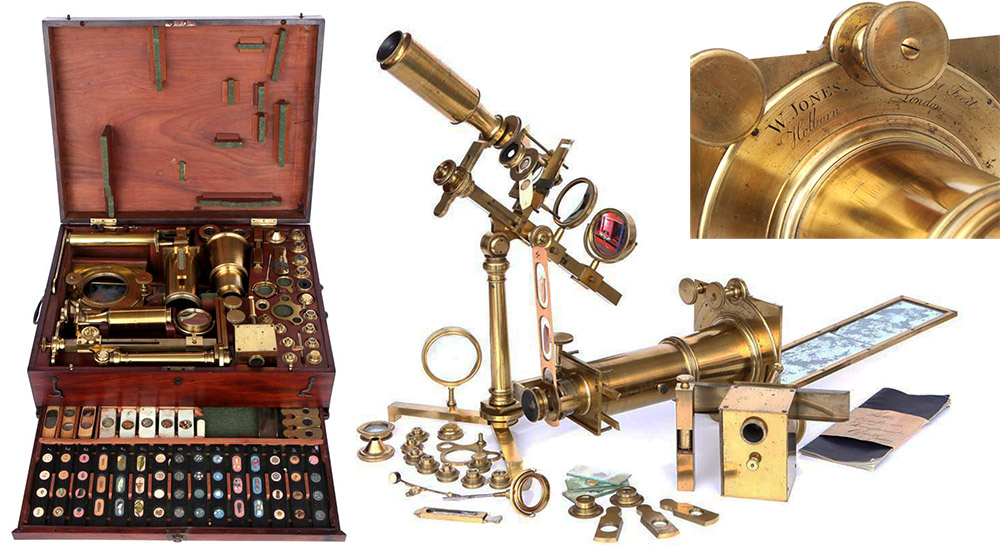
Figure 10.
1780s microscope compendium signed “W. Jones”, consisting of a “new improved universal microscope” (later to be renamed Jones Most Improved), a solar microscope for transparent and opaque objects, and numerous accessories and specimens. Images adapted for nonprofit, educational purposes from an internet auction site.
Figure 11, 1791 catalogue from W. and S. Jones:






Figure 11.
The 1791 catalogue of W. and S. Jones, the earliest known reference to the brothers’ partnership. In addition to nine pages of optical and scientific instruments, the catalogue lists two pages of novelties, “instruments of recreation and amusement”.

Figure 12.
“Jones improved lucernal microscope”. Top, as illustrated in George Adams Jr’s 1798 “Essays on the Microscope”. Bottom, a surviving microscope. Image adapted for nonprofit, educational purposes from https://collection.sciencemuseum.org.uk/objects/co8712/lucernal-microscope-c-1795-by-w-s-jones-60-holbo.

Figure 13.
Folding “flower” microscopes are often attributed to W. and S. Jones, although they were produced by numerous manufacturers from the late 1700s until well into the 1800s. The left panel is an illustration of a “small pocket microscope for insects or flowers”, from Adams’ 1798 edition of “Essays on the Microscope”, published by W. and S. Jones.

Figure 14.
A ca. 1780-1800 compass-type microscope, signed by W. and S. Jones, with their pre-1880 address of 135 Holborn. The red painted cabinet suggests that it may have been manufactured by Benjamin Martin; Jones acquired book rights and apparatus from Martin after his death. Compass microscopes with accessories do not appear to be listed in any of Jones’ catalogues, so this may have been part of a larger compendium and/or an acquisition from Martin that was stamped with the Jones’ names. Images adapted for nonprofit, educational purposes from an internet auction site.

Figure 15.
“A box containing 4 numbers and 4 letters, the order of which may be discovered, if ever so secretly placed, by means of a curious magic perspective”, which retailed for 10 s 6d in W. and S. Jones’ 1791 catalogue. Each block contains a piece of iron, each in a different corner. The “curious magic perspective” contains a rotating disc with four letters and numbers printed on either side, and an eccentrically-placed magnet. When the lid is closed, and the “curious magic perspective” is moved across the lid, the magnet rotates the disc as it passes over the iron in the hidden tiles. The appropriate letter or number appears in the window. Photographed from the scientific instrument collection of Transylvania University, Lexington, Kentucky.
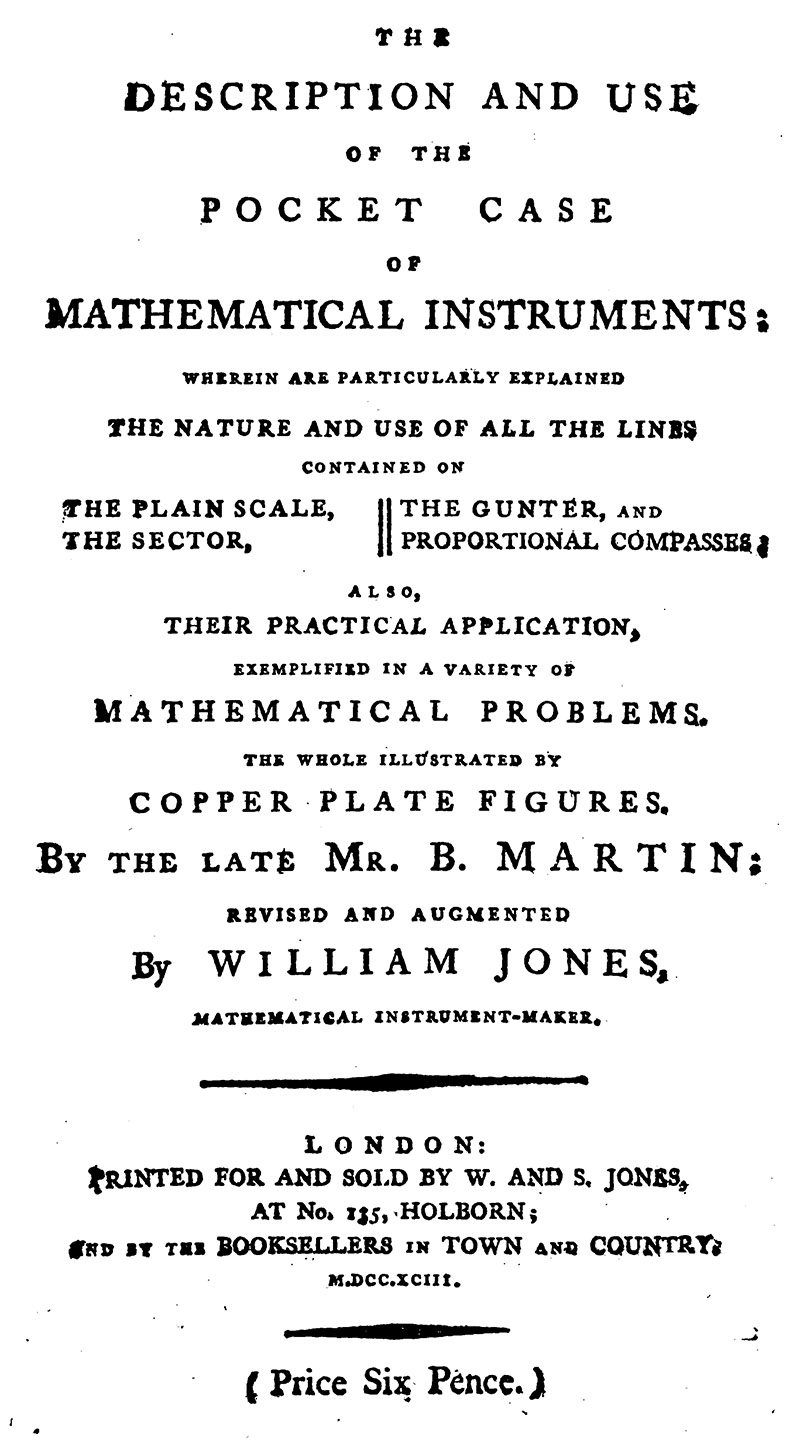
Figure 16.
Title page of W. & S. Jones’ 1793 reprint of Benjamin Martin’s “The Description and Use of the Pocket Case of Mathematical Instruments”. This edition was “revised and augmented by William Jones, mathematical instrument-maker”. Listing both men’s names as authors would cause readers to associate Jones with Martin, a strategic marketing move.

Figure 17.
A pocket case of mathematical instruments. The shagreen-covered case is 7 inches / 13 cm long, and holds an ivory ruler, ivory and brass sector, protractor, dividers, and various interchangeable drawing/marking implements for the dividers. A label from w. & S. Jones is pasted inside the lid. The address on the label is 30 Holloway, to which the Jones moved in 1800.

Figure 18.
Two pages from W. & S. Jones’ catalogue that was included in their 1798 edition of Adams’ “Essays on the Microscope”. They note that they “have purchased the stock and copyright of several philosophical essays by the late Mr. George Adams … and that they are now sold at their shop in Holborn”. Listed works were, “An Essay on Electricity”, “An Essay on Vision”, Astronomical and Geographical Essays”, An Introduction to Practical Astronomy”, Geometrical and Graphical essays”, “An Appendix to the Geometrical and Graphical Essays”, and “Lectures on Natural and Experimental Philosophy”.

Figure 19.
A 1799 announcement of Jones’ publication of Adams’ “Essays on Electricity” and William Jones’ “Use of the Globes”, and a note that W. and S. Jones was a manufacturer of globes. From “The Monthly Magazine”.

Figure 20.
A globe by W. and S. Jones. The address indicates that it was manufactured after 1800 (see Figure 21). This is a pocket-sized globe, 2.75 inches in diameter, with celestial markings on the inside of the spherical case. Adapted for nonprofit, educational purposes from an internet retail site.

Figure 21.
Catalogues from 1799 and 1800 document the Jones’ move from 135 Holborn to 30 Holborn.

Figure 22.
The W. & S. Jones sextant that was carried by Meriwether Lewis and William Clark on their 1804-1806 exploration of the American west.

Figure 23.
An 1831 W. and S. Jones Bohnenberger gyroscope. However, the craftsman who actually made the instrument, William Stiles, signed his name inside the hollow wooden rotor. Adapted for nonprofit, educational purposes from http://nms.scran.ac.uk/database/record.php?usi=000-180-001-010-C&scache=1b301r0vxh&searchdb=scran

Figure 24.
A ca. 1840 polarimeter signed by W. and S. Jones. However, it was undoubtedly produced by William Darker, the era’s foremost manufacturer of polarizing apparatus, and who was known to have worked on contract to make such instruments for the Jones brothers. Adapted for nonprofit, educational purposes from http://waywiser.fas.harvard.edu/objects/9696/polarimeter

Figure 25.
Excerpt from an 1837 W. & S. Jones catalogue, showing the varieties of microscopes that they stocked at that time.

Figure 26.
An unsigned microscope of a form that strongly resembles Jones’ “universal pocket microscope” (a.k.a. “Jones botanical”, Figure 3, above). Is this an example of the “new improved universal microscope” that W. and S. Jones advertised in 1837?

Figure 27.
A ca. 1840s microscope, marked “Jones, 30 Holborn, London” on the base. Adapted for nonprofit, educational purposes from an internet auction site.
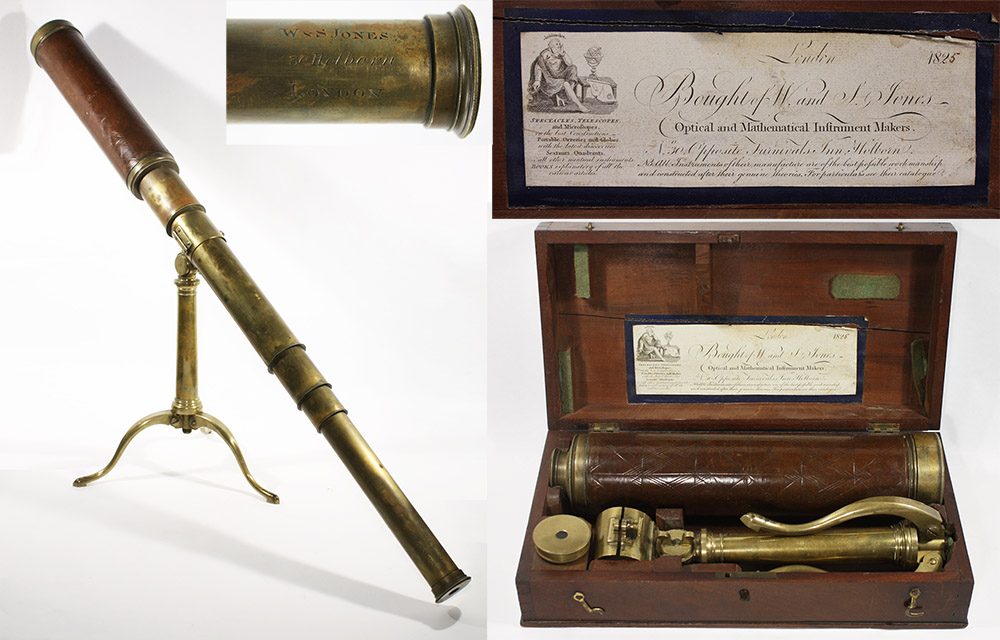
Figure 28A.
A 2 1/2inch refracting telescope by W. & S. Jones. The label bears the date 1825. Adapted for nonprofit, educational purposes from an internet auction site.
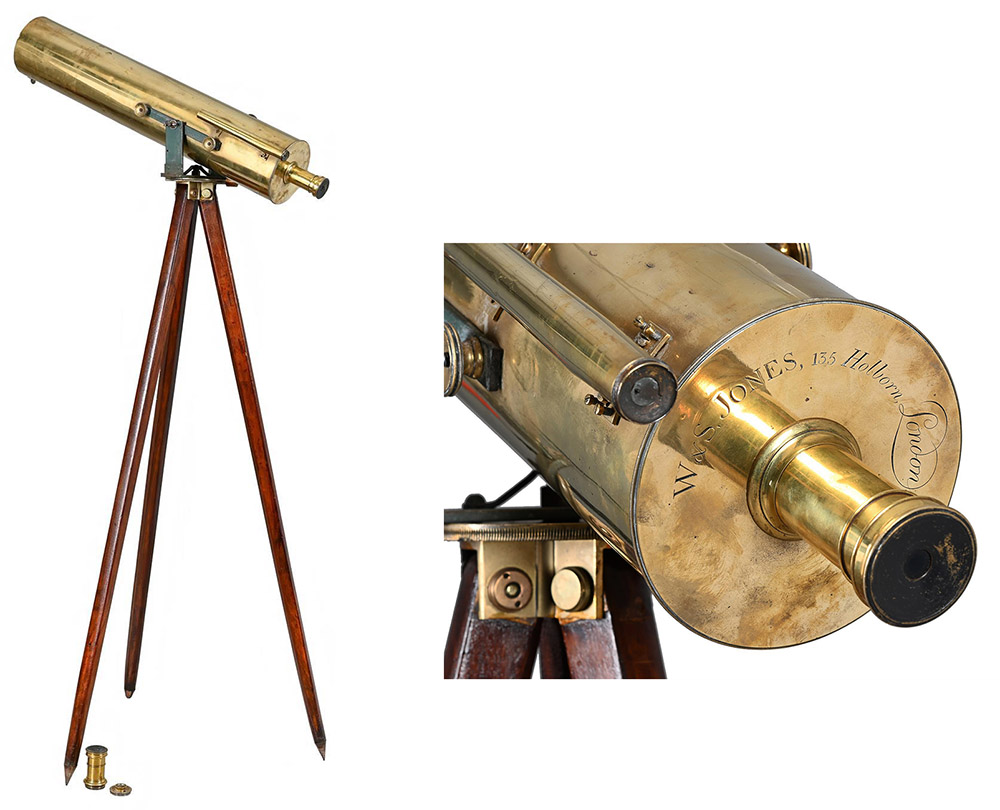
Figure 28B.
A 6 inch Gregorian reflecting telescope, with 33 inch body tube, manufactured by W. & S. Jones. Adapted for nonprofit, educational purposes from an internet auction site.

Figure 28C.
A small, portable refracting telescope from W. & S. Jones. This clever design collapses and packs into a pocket-sized tube. Assembled, it is 13 inches / 33 cm long, and 10 inches / 25 cm tall. It has a triple element lens of 1 inch / 32mm diameter, giving an 18x magnification. Adapted for nonprofit, educational purposes from an internet auction site.

Figure 29.
A W. & S. Jones barometer. Adapted for nonprofit, educational purposes from an internet auction site.
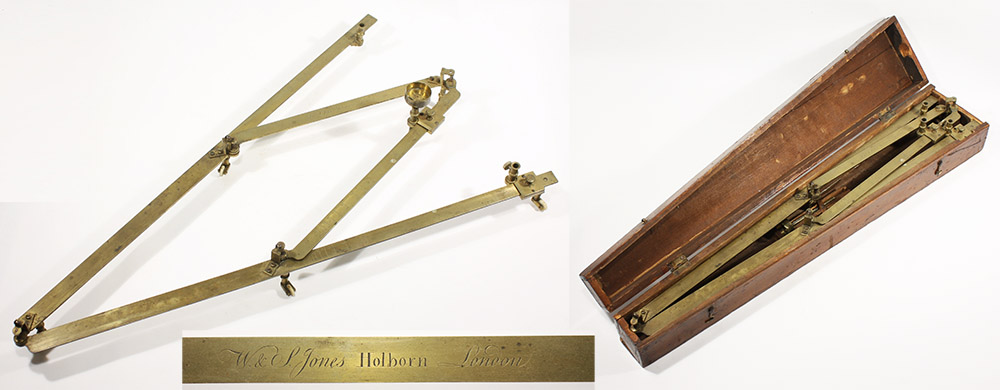
Figure 30.
A pantograph by W. & S. Jones. Adapted for nonprofit, educational purposes from an internet auction site.

Figure 31.
A compass from W. & S. Jones. Adapted for nonprofit, educational purposes from an internet auction site.
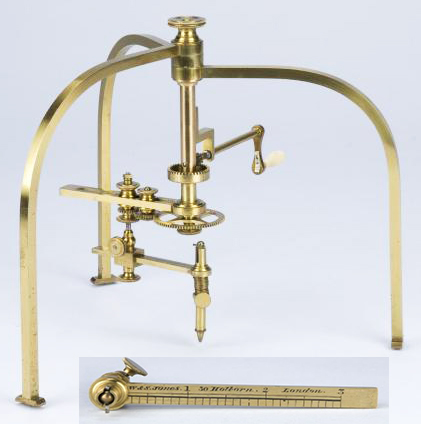
Figure 32.
A “geometric pen” or “ellipsograph” by W. and S. Jones. In the Harvard University Collection of Historical Scientific Instruments. From their description, “The frame of this drawing instrument is made of three curved legs, contrived to fold within one another for convenience of packaging. Under the center point is a vertical axis supporting a fixed pinion and shaft handle. To the lower part of the axis, any of the gear wheels can be adapted. From the lower part of the central axis an arm is fixed and contrived to turn around the main axis. On that arm are two sliding attachments, on which any gear wheel can be attached. At the end of that arm, another one is fixed that carries the pencil. It can slide backwards and forwards to vary the distance of the pencil to its supporting attachment. The great number of wheels produce hundreds (even thousands) of different geometrical curves. The number of teeth on each wheel is engraved on them. Everything is stored is a small mahogany box”. Adapted for nonprofit, educational purposes from http://waywiser.fas.harvard.edu/objects/12596/geometric-pen-or-ellipsograph.

Figure 33.
A W. & S. Jones double-barreled air pump. In the Harvard University Collection of Historical Scientific Instruments. Adapted for nonprofit, educational purposes from http://waywiser.fas.harvard.edu/objects/13035/doublebarreled-air-pump

Figure 34.
An electrical discharge globe by W. and S. Jones. In the Harvard University Collection of Historical Scientific Instruments. Adapted for nonprofit, educational purposes from http://waywiser.fas.harvard.edu/objects/13728/discharge-globe
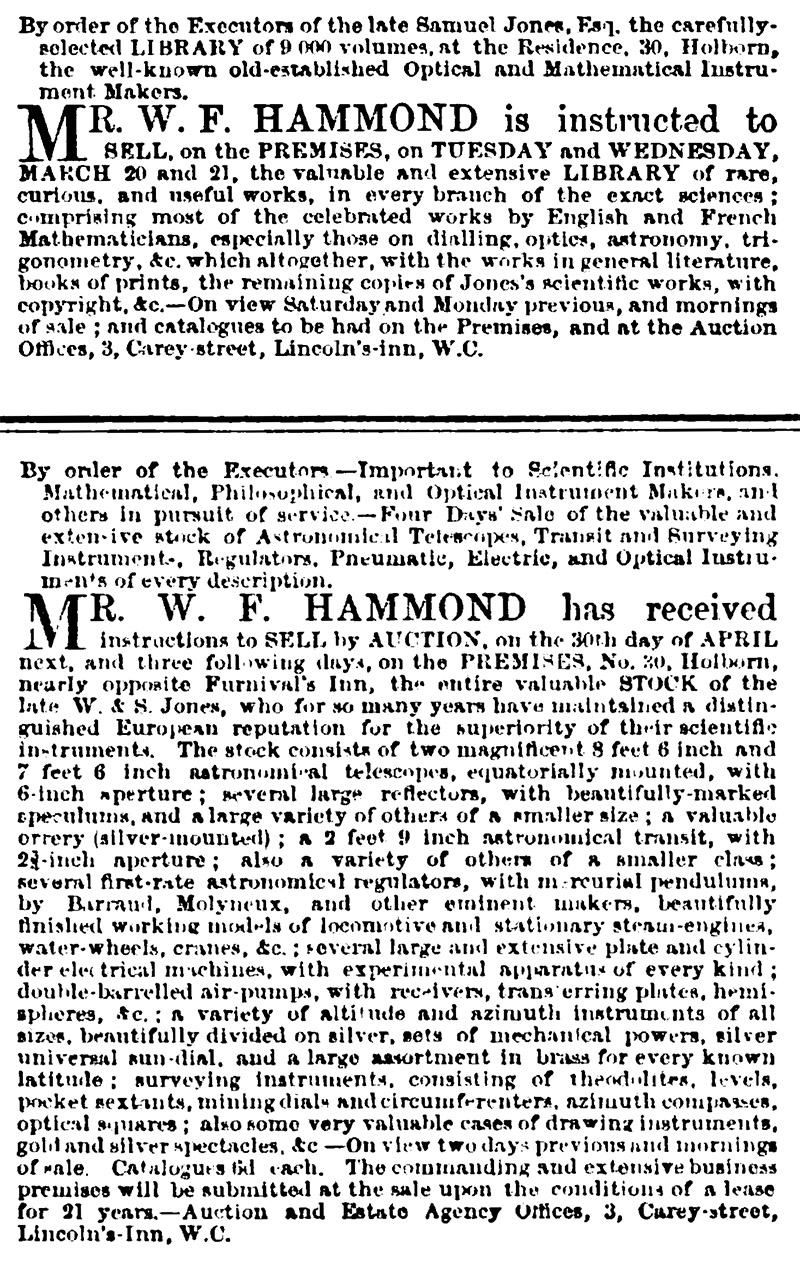
Figure 35.
1860 advertisements for the auction of the personal belongings of Samuel Jones, and the stock of W. & S. Jones. From “The Builder”, March 17 and 31 issues.

Figure 36.
Illustrations from "Tallis’ London Street Views" of the buildings on Holborn Hill, 1838. W. & S. Jones’ shop was at number 30, near the corner of Fetter Lane (marked with a red asterisk). Their shop until 1800 was across the road, at number 135; when this image was produced, that building had been incorporated into The Bell and Crown Hotel (marked with a blue asterisk). It is adjacent to Furnival’s Inn, which the Jones frequently noted in their advertisements.
Acknowledgements
Thank you to Joe Zeligs for many conversations on early microscopy and for thoughtful input on this essay.
Resources
Adams, George (1787) Essays on the Microscope
Adams, George (1798) Essays on the Microscope, edited by Frederick Kanmacher
Adams, George (1785) An Essay on Electricity
Adams, George, and William Jones (1799) An Essay on Electricity
Adams, George (1789) Astronomical and Geographical Essays
Adams, George, and William Jones (1803) Astronomical and Geographical Essays
Adams, George, and William Jones (1812) Astronomical and Geographical Essays
Adams, George (1791) Geometrical and Graphical Essays
Adams, George, and William Jones (1807) Geometrical and Graphical Essays
Adams, George, and William Jones (1813) Geometrical and Graphical Essays
Adams, George (1794) Lectures on Natural and Experimental Philosophy
Adams, George, and William Jones (1799) Lectures on Natural and Experimental Philosophy
The Athenaeum (1808) Died: “At Islington, aged 71, Mr. John Jones, formerly an eminent optician in Holborn”, page 266
Baptism record of William Jones (1762) Parish records of St Andrew Holborn
Baptism record of William Jones (1770) Parish records of St Andrew Holborn
Battler, Kemp Plummer (1974) History of the University of North Carolina, Vol. 1, from 1789-1868, page 294
Brown, Leland Arthur (1959) Early Philosophical Apparatus at Transylvania College, Transylvania College Press, Lexington, Kentucky
The Builder (1860) Announcements of auctions of Samuel Jones’ estate, Vol. 18, March 17 and March 31 advertising sections
England census and other records, accessed through ancestry.com
The Gentleman’s Magazine (1831) Obituary of William Jones, Vol. 149, page 275
Harvard University Collection of Historical Scientific Instruments, on-line (accessed August, 2019) http://waywiser.fas.harvard.edu/people/1032/w--s-jones;jsessionid=10DDF2A6A55E372C5BB78F1C0695432B/objects
Jones, William (1782) The Description and Use of a New Portable Orrery, printed for John Jones, London
Jones, William (1784) The Description and Use of a New Portable Orrery
Jones, William (1787) The Description and Use of a New Portable Orrery (includes catalogue of J. Jones and Son)
Jones, William (1799) The Description and Use of a New Portable Orrery, W. & S. Jones, London
Jones, William (1795) Methods of Finding a True Meridian Line, Useful in Placing Horizontal Sun Dials, Setting Clocks and Watches, &c., W. & S. Jones, London
Jones, William (1804) Observations on Dr. Wollaston's statements respecting improvement in the form of spectacle-glasses, Philosophical Magazine, February 29 issue, pages 65-71
Jones, William, and Samuel Jones (1791) A Catalogue of Optical, Mathematical, and Philosophical Instruments, Made and Sold by Willm. and Saml. Jones, at Their shop, No. 135, Next Furnival's Inn, Holborn, London
Journal of Natural Philosophy, Chemistry and the Arts (1797) Review of Geometrical and Graphical Essays, Vol. 1, pages 191-192
Kent’s Directory of London (1803) “Jones W. & S. Opticians, &c., 30, Lower Holborn”, page 112
Kent’s Directory of London (1823) “Jones W. & S. opticians, &c., 30, Holborn-hill”, page 190
Letter from William Jones to Thomas Jefferson (1789) accessed from https://founders.archives.gov/documents/Jefferson/01-14-02-0187
Letter from William and Samuel Jones to Thomas Jefferson (1793) accessed from https://founders.archives.gov/documents/Jefferson/01-25-02-0305
Letter from William and Samuel Jones to Thomas Jefferson (1805) accessed from https://founders.archives.gov/documents/Jefferson/99-01-02-2140
Letter from William and Samuel Jones to Thomas Jefferson (1807) accessed from https://founders.archives.gov/documents/Jefferson/99-01-02-6586
Lorimer, John (1800) A Concise Essay on Magnetism, W. & S. Jones, London
Lowndes’ London Directory (1786) “Jones, John, mathematical instrument maker, 135, Holborn” page 107
Marriage record of John Jones and Elizabeth Tomkins (1757) Parish records of St Andrew Holborn, November 27
Martin, Benjamin (1771) Description and Use of the Pocket Case of Mathematical Instruments, Martin, London
Martin, Benjamin, and Jones, William (1793) Description and Use of the Pocket Case of Mathematical Instruments, W. & S. Jones, London
Martin, Benjamin, and Jones, William (1797) Description and Use of the Pocket Case of Mathematical Instruments, W. & S. Jones, London
Martin, Benjamin (1775) An Explanation of a New Construction and Improvement of the Sea Octant and Sextant, Martin, London
Martin, Benjamin, and Jones, William (1795) The Description and Use of the Sea Octant Commonly called Hadley's Quadrant, W. & S. Jones, London
Milburn, John R. (2000) Adams of Fleet Street, Ashgate, Aldershot, Hampshire
Milburn, John R. (1976) Benjamin Martin: Author, Instrument-Maker, and ‘Country Showman’, Springer
The Monthly Magazine (1799) Announcement of books published by W. and S. Jones, May 1 issue, page 320
Morrison-Low, Alison D. (2017) Making Scientific Instruments in the Industrial Revolution, Ashgate, Aldershot, Hampshire, pages 164-174
Official Catalogue of the Great Exhibition of the Works of Industry of All Nations (1851) “141 Jones, W. & S., 30 Holborn - A mountain thermometer”, page 62
Probate of the will of John Jones (1808) accessed through ancestry.com
Probate of the will of William Jones (1831) accessed through ancestry.com
Probate of the will of Samuel Jones (1859) “Jones Samuel Esq. 15 December The Will with a Codicil of Samuel Jones late of 30 Holborn in the Parish of St Andrew Holborn in the City of London and of Dalton House St Albans in the Parish of St Peter in the County of Hertford Esquire deceased who died (on or before) 10 October 1859 at Dalton House aforesaid was proved at the Principal Registry by the oaths of Charles Harriott Smith of 24 Hatton-garden in the County of Middlesex Surveyor James Molyneux Taylor of 51 Guildford-street Russell-square in the same County Esquire and Jeremiah Kelly of the same place Gentleman the Executors. Effects under £25,000”, accessed through ancestry.com
Simpson, Allen D.C. (1995) ‘La plus brilliante collection qui existe au monde’, a lost American collection of the nineteenth century, Journal of the History of Collections, Vol. 7, pages 187-196
The Solicitor’s Journal and Reporter (1860) Professional partnerships dissolved, Vol. 4, page 949
Tallis’ London Street Views 1838-1840 (2002) London Topographical Society, page 47
















































